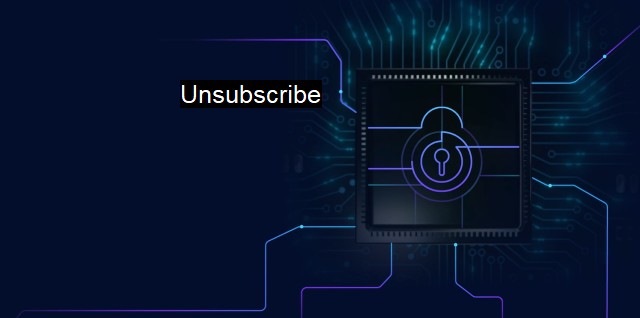What is Unsubscribe?
Unsubscribing from Spam: Understanding the Importance of Cybersecurity in Opting-Out of Email Marketing
"Unsubscribe" pertains to the act of removing oneself from an online mailing list or service. It is a common feature in almost all legitimate email communication, allowing users to opt out from receiving any more updates or communications from mailing lists, newsletters, social media updates, commercial emails, and other digital communications.Many service providers, online businesses, or any other groups use the subscription model to keep their users or customers updated about their newly launched products, deals, or simply to share information they think might be helpful or of interest. When you provide your email address to such organizations, you naturally become a target for their emails. for users who no longer wish to receive those emails for any reason, the "unsubscribe" options serve as an escape hatch.
In most cases, the "unsubscribe" link is located at the bottom of newsletters or marketing emails. Sometimes, users need to log into their account on the specific platform and change their communication preferences from their settings. Once the user chooses to unsubscribe, they are expected not to receive any emails from that sender, or in the case where preferences can be set, not to receive the specific type of emails they unsubscribed from.
From a cybersecurity standpoint, the whole process of unsubscribing seems straightforward, but often users can find themselves tangled in the complexities and dangers tagged with the 'unsubscribe' term. Not all that glitters is gold; not every 'unsubscribe' link should be clicked.
The main reason for such caution is cybersecurity threats or malware, disguised as seemingly innocent and even desirable, namely - Unsubscribe buttons. Phishing is a common type of cybersecurity attack where attackers send seemingly legit emails that appear to come from a credible source to spread viruses or steal sensitive data like usernames, passwords, credit card numbers, among others. These emails usually require an action from the receiving end - clicking a link, downloading an attachment, revealing certain information. 'Unsubscribe' links within such phishing emails often carry direct download malware or link to malicious sites designed to harvest user data or credentials upon click. Clicking the unsubscribe button in these emails may not only fail to halt the emails, it can also lead to other adverse effects like exposure to a virus or data theft.
Antivirus software is an effective way to counteract the hidden threat in unsubscribe links. These solutions are designed to detect and eliminate threats that might present before they can affect the system. They may scrutinize URLs, block downloads of suspicious files, among many protective features. It’s thus essential for everyone, from individual digital users to businesses, to have a dependable antivirus solution and keep it updated in order that it has all of the latest threat definitions.
A safety practice that all users should adopt is to never just click the unsubscribe link. Rahter, users should confirm the sender's accurate identity and the email's legitimacy. If they don’t recognize the email, it’s best not to try unsubscribing. Training able to recognize fake unsubscribe links, phishing emails, unusual email templates, and much more helps limit the phishing threat considerably. Spam and junk filters should also be used as they help tag suspicious emails and keep them isolated.
In the same way that attackers are constantly upscaling their methods to bypass security features, individuals and infrastructures must maintain their knowledge updated about these techniques and actively take actions that align with the best cybersecurity practices. The term unsubscribe, whether legitimate or malicious, provides the perfect window into understanding and implementing steps towards adhering to online security practices.

| | A | | | B | | | C | | | D | | | E | | | F | | | G | | | H | | | I | | | J | | | K | | | L | | | M | |
| | N | | | O | | | P | | | Q | | | R | | | S | | | T | | | U | | | V | | | W | | | X | | | Y | | | Z | |
| | 1 | | | 2 | | | 3 | | | 4 | | | 7 | | | 8 | | |||||||